
The JSR Group believes that preventing a major crisis from occurring and minimizing its effects on business activities is an important management role. The Group has formulated Risk Management Policies and established a Risk Management Committee through which it actively pursues risk management activities.
JSR Group risk management is handled by the Risk Management Committee, which performs group-wide risk management and formulates response policies concerning actual and potential risks other than those arising in the normal course of business that are addressed in major conferences such as meetings of the Board of Directors*.
* Risks arising in the normal course of business that are addressed in major conferences, such as meetings of the Board of Directors are strategic risks that include those associated with capital investment and M&A.
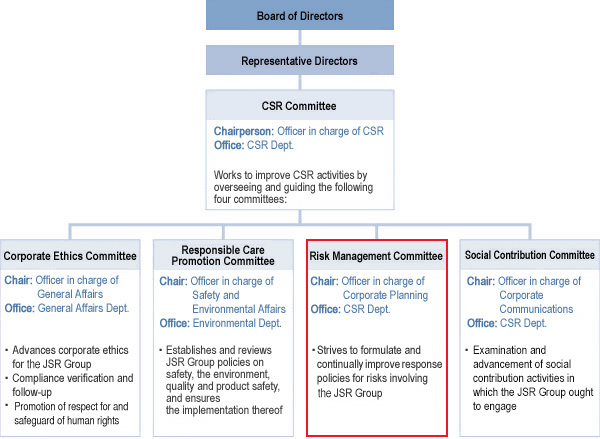
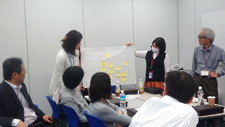
Since FY2010, the JSR Group has fulfilled group-wide annual risk management procedures using its unique risk management system under the initiative of the Risk Management Committee. For each division of JSR Group companies in and outside of Japan, we identify and evaluate all potential risks, and formulate measures to control such risks. In FY2016, we revised risk identification methods after reviewing the validity of previous JSR Group risk management. Utilizing a risk map that represents level of business impact and frequency of occurrence, we identified risks that could have a significant impact on business continuity. We have organized these risks into the JSR Group Risk Factors for which senior management are personally responsible.
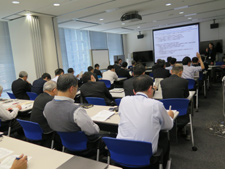
In FY2016, we held risk management workshops for department managers and various group company representatives to solidify the importance of risk management.
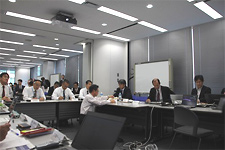
The Headquarter for Accident & Disaster Control
Members from the headquarters for accident & disaster control, with the President acting as the Director, conduct crisis management training once per year. In FY2016, training at the Head Office (Minato Ward, Tokyo) was conducted using a scenario in which an earthquake occurs in the northern area of Tokyo Bay.
The training was also conducted along the scenario that disaster had affected the Chiba Plant, Kashima Plant, and Tsukuba Research Laboratories. Simulations were run for scenarios in which secondary disaster occurs so that employees would be better equipped to gather information properly during such events. This training also helps to better define response policies and specific roles to different departments.
We will continue to perform this kind of training to be more prepared for emergencies and ensure safety, damage control, and business continuity.
JSR Group conducts disaster management and evacuation training and drills on a regular basis. It is imperative that we minimize the effects of emergencies and ensure business continuity in such situations.
In FY2010, we introduced a safety confirmation system to promptly confirm the safety of our employees in the event of a large-scale earthquake or other disaster. In FY2012, we expanded the system's coverage to our Group companies and the families of our employees.
In the case of an epidemic or the spread of influenza and other infections, we stockpile drugs and masks.
We also provide necessary information such as the announcement of flu outbreaks.
Procedures which comprises BCM/BCP* systems in place for both peacetime and emergency situations.
These procedures define the BCM organization and the actual BCP, which includes stipulations on target recovery times, and BCP activation and cancellation standards. They also define the organizational structure that takes effect during activations of the BCP, and corresponding priority businesses and operations.
* BCM: Business Continuity Management/BCP: Business Continuity Plan
A BCP defines activities that need be conducted before the occurrence of an emergency situation that may threaten the survival of a company (large-scale natural disaster, explosion/fire, terrorist attack, etc.), judgment criteria and action guidelines that enable business continuity in the event of such emergencies, and other matters necessary for ensuring the continuity and early restoration of important businesses. BCM is a management system that has been developed to operate and continuously improve the BCP through a PDCA (plan-do-check-act) cycle.
JSR Group adopted a mid-term business plan in FY1996 concerning preparations for a major earthquake and has been conducting systematic activities to enhance those preparations. After FY2007, we began a seismic retrofitting project focused on high-pressure gas facilities in our plants, and installed an earthquake early-warning system at all JSR business sites. Based on lessons learned from the experience of the Great East Japan Earthquake, we are further reinforcing the anti-seismic capabilities of our buildings and implementing safety measures by incorporating the perspective of countermeasures against tsunamis. These initiatives are scheduled for completion by FY2018.
The Yokkaichi Plant Administration Building, completed in December of 2013, can withstand earthquakes of up to 600 Gals using two types of seismic isolators: laminated rubber and oil dampers. In addition, the lattice structure ground improvement method was used to prevent liquefaction to help further improve resistance to earthquakes. This building has warehouses in preparation for disasters and was designed to ensure enough space for the headquarter functions to continue in the event of disasters in the headquarter region (metropolitan Tokyo area). This building also functions as the Yokkaichi City Tsunami Evacuation Building for local residents.
Completed in July of 2014, Yokkaichi Plant Clean Room Building C incorporates advanced soil liquefaction prevention measures and a seismic isolation structure to ensure the stable operation of precision instruments and resistance to earthquakes. Valuable equipment is installed in higher floors to prevent possible damage from tsunamis.
The JSR Group adopted an Information Security Policy and is working to implement appropriate information management by informing all personnel of the policy.
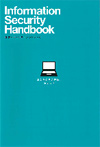
Information security handbook
JSR Group is continually working together with external experts to increase our level of security and protect corporate information assets from cyber-attacks. In FY2015, we issued an Information Security handbook to raise employee sensitivity to information leakage risks and help ensure that employees are aware of and follow rules regarding information security. We also conduct targeted attack drills using fake viruses to raise prevention awareness. In addition, we are engaged in raising awareness of the content in the Information Security handbook through e-learning and workplace meetings.
Each JSR Group company defines legal compliance regulations that form the basis of the organization's legal compliance. Each company utilizes these regulations to review and improve legal compliance regularly. Each company also provides legal training to increase awareness of laws and regulations and improve commitment to compliance.
Laws and regulations that are particularly relevant to execution of business are identified as Overall Significant Laws and Legal regulations. We also concentrate on establishing individual systems to ensure compliance with these critical laws and regulations.
In addition to the Japanese version already released, a South Korean version of the Compliance Handbook prepared in accordance with South Korean law was issued in FY2016. This handbook has been distributed to all South Korean Group companies to increase awareness and commitment to compliance in South Korea.